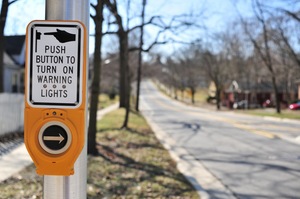
Ryan J. Stanton | AnnArbor.com
This multi-jurisdiction project is just one of a series of similar efforts in the Ann Arbor area. The city is working to develop a vision for the South State Street corridor; a task force is discussing ideas to improve the North Main / Huron River corridor; and a proposed "road diet" for Jackson Avenue remains in play. Running parallel to and in conjunction with these efforts, earlier this spring Ann Arbor released a draft update to its Non-Motorized Transportation Plan. Meanwhile, some of the same concerns are being kept in mind as Ypsilanti reconsiders its master plan.
Taken together, it can all seem overwhelming. And in fact, all the ideas and proposals do represent an awful lot of potential change.
But these projects are vital parts of maintaining the vibrancy of the Ann Arbor community. In particular, the emphasis on keeping the needs of pedestrians, bicyclists and mass transit in mind, as well as individual drivers, should serve the community well as we move into the future.
As the nationwide "Complete Streets" initiative has noted, for decades, infrastructure improvements in the U.S. focused largely on efficiently moving individual automobile traffic, all too often at the expense of other types of transportation. In recent years, however, a realization seems to be taking hold that maybe a somewhat more balanced perspective would improve our communities.
Make no mistake: Despite the sometimes over-the-top objections to the recent transportation ideas here and elsewhere, nobody seriously suggests individual automobiles should go away, or even that their needs shouldn't be considered and accommodated. We as a society do a lot of driving, and we're going to continue to do so. Most of us drive to work every day, and to the store, and to leisure-time activities.
But most of us walk, too, even if only after parking our cars. And an increasing number get to work by bicycle. In Ann Arbor, census figures indicate more than 20 percent of the population either walks or bikes to work. The city's Nonmotorized Transportation Plan update notes that bicycles rose from from 2.4 to 3.5 percent of total commuting trips between 2000 and 2006. And test counts of bicycle use before and after new bike lanes were added at two locations (Liberty and Seventh, Miller and First) showed increases of 38 and 30 percent from 2006/2007 to 2011.
With gas prices stuck at historically high levels and shifts in attitudes toward commuting alternatives, it's hard to imagine these numbers doing anything other than rising in future years.
Not every idea now being considered will become reality. Some will probably happen soon; others years from now; others never. That's appropriate. The important thing is that the conversations are taking place, and taking place now. The country is changing, and our community will be better served by leading than by following.